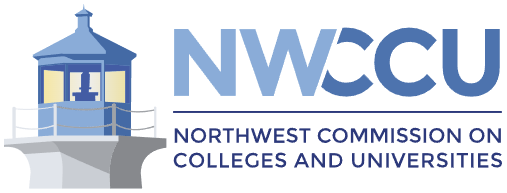EHHD_ED_UG_BS_TEP_K-8_and_Secondary_PLAN_2016-20
The Technology Education Broadfield and Tech Ed Industrial Technology programs have now been moved out of the Department of Education and into the Department of Agricultural and Technology Education.
Montana State University ‐ Bozeman
Department of Education
Program Assessment System Plan
All Department of Education majors and minors are part of the Teacher Education Program and are included in the TEP assessment system, with the exception of the Tech Ed Industrial Technology Option (TEIT) which has its own assessment plan.
| Sheet Tabs (linked) | Contents |
| Intro | This sheet. The Back to Top link on each sheet returns to this sheet. |
| TEP ‐ Step 1 | Teacher Education Program ‐ Outcomes |
| ELED ‐ Step 2 | Elementary Education ‐ Delivery Matrix |
| ELED ‐ Step 3 | Elementary Education ‐ Assessment Matrix |
| EDGS ‐ Step 2 | General Science Broadfield ‐ Delivery Matrix |
| EDGS ‐ Step 3 | General Science Broadfield ‐ Assessment Matrix |
| EDSS ‐ Step 2 | Social Studies Broadfield ‐ Delivery Matrix |
| EDSS ‐ Step 3 | Social Studies Broadfield ‐ Assessment Matrix |
| TEBD ‐ Step 2 | Technology Education Broadfield ‐ Delivery Matrix |
| TEBD ‐ Step 3 | Technology Education Broadfield ‐ Assessment Matrix |
| Minors Step 2 | Reading and Tech Ed Teaching Minors ‐ Delivery Matrix |
| Minors Step 3 | Reading and Tech Ed Teaching Minors ‐ Assessment Matrix |
| TEP Step 4 ‐ Expectation | Teacher Education Program ‐ Assessment Expectations |
| TEP Step 5 ‐ Schedule | Teacher Education Program ‐ Assessment Schedule |
| TEP Step 6 ‐ Process | Teacher Education Program ‐ Assessment Process |
| TEIT Step 1 | Tech Ed Industrial Technology Option ‐ Outcomes |
| TEIT Step 2 | Tech Ed Industrial Technology Option ‐ Delivery Matrix |
| TEIT Step 3 | Tech Ed Industrial Technology Option ‐ Assessment Matrix |
| TEIT Step 4 ‐ Expectation | Tech Ed Industrial Technology Option ‐ Assessment Expectations |
| TEIT Step 5 ‐ Schedule | Tech Ed Industrial Technology Option ‐ Assessment Schedule |
| TEIT Step 6 ‐ Process | Tech Ed Industrial Technology Option ‐ Assessment Process |
| FEPA Rubric | TEP ‐ Field Experience Performance Assessment Rubric |
| TWS Rubric | TEP ‐ Teacher Work Sample Rubric |
| TEP ‐ SA Rubrics 1 | TEP ‐ Signature Assignments ‐ Rubrics |
| TEP ‐ SA Rubrics 2 | TEP ‐ Signature Assignments ‐ Rubrics |
| TEIT Rubric 1 | Tech Ed Industrial Technology Option Rubrics |
| TEIT Rubric 2 | Tech Ed Industrial Technology Option Rubrics |
| TEIT Rubric 3 | Tech Ed Industrial Technology Option Rubrics |
| TEIT Rubric 4 | Tech Ed Industrial Technology Option Rubrics |
Program Learning Outcomes
ELED, EDGS, EDSS and TEBD majors; TRDG and TTCH minors
1 |
Content | Candidates understand the central concepts, tools of inquiry, and structures of the disciplines and can create standards‐based learning experiences that make these aspects of subjects or content knowledge meaningful for students. |
2 |
Diversity | Candidates create learning environments that allow ALL students to be socially and academically successful, by validating students’ cultural heritages, integrating their life experiences, and promoting their overall development. Candidates demonstrate knowledge, skills, and dispositions to address the instructional responsibilities needed to integrate Indian Education for All across the curriculum in a culturally responsive manner. |
3 |
Pedagogy | Candidates understand and use a variety of instructional strategies to foster students’ motivation for learning and encourage the development of students’conceptual understandings and performance/work force skills. Candidates use knowledge of effective communication techniques and make appropriate use of educational technology to support planning, instruction, and student learning. |
4 |
Assessment |
Candidates understand and demonstrate use of formal and informal assessment strategies and tools to direct planning of instruction for the continuous intellectual, social and physical development of all learners. This ongoing practice includes pre‐, formative and summative analysis of student learning, individually, in groups, and in whole class settings. Candidates plan lessons and instructional sequences are based upon knowledge of subject matter, standards, learning outcomes, students, and the community. |
5 |
Professionalism | Candidates demonstrate the ability to reflect on classroom decision‐making with regard to content, diversity, pedagogy and assessment in order to improve teaching and learning. Candidates are reflective practitioners that examine their own biases and endeavor to provide equitable educational opportunities for students. Candidates demonstrate an understanding that education happens in a context and develop effective relationships with family and community members. |
Delivery ‐ Elementary Education
| I = Introductory | Outcomes | |||||
| D = Developmental | Content | Diversity | Pedagogy | Assessment | Professionalism | |
| M = Mastery | Cr | 1 | 2 | 3 | 4 | 5 |
| EDU 101 US Teaching & Learning | 3 | I | I | I | ||
| WRIT 101 W College Writing | 3 | I | ||||
| EDU 222 IS Ed Psych and Child Development | 3 | I | ||||
| Life Science: BIOB 100IN; BIOM 103IN; or approved elective | 3 | I | ||||
| M 132 Number and Operations for K-8 Teachers | 3 | I | ||||
| EDU 204 IA Creative Arts & Lifelong Learning | 3 | I | ||||
| HSTA 101 or 102 or HSTR101 or 102 IH American History I or II or Western Civilization I or II | 4 | I | ||||
| GPHY121; GPHY 141; ANTY101 Human Cultures | 3 | I | ||||
| Earth Science: GEO 101; GEO103; GPHY111; or approved elective | 3-4 | I | ||||
| M 133Q Geometry and Geometric Measurement for K-8 Teachers | 3 | I | ||||
| EDU 370 Integrating Technology into Education | 2 | I | ||||
| TE 250 CS Technology & Society | 3 | I | ||||
| Physical Science: PHSX 103IN; PHSX201IN; CHMY102; or approved elective | 3-4 | I | ||||
| M 234 Higher Mathematics for K-8 Teachers | 3 | I | ||||
| NASX 105, or 205, or 232 Native American Studies | 3 | I | ||||
| EDU 331 Literature & Literacy for Children | 3 | I | I | |||
| Approved STEM elective | 3 | I | ||||
| PSCI 210 American Government | 3 | I | ||||
| EDU 397 K-8 Health Enhancement | 3 | I | ||||
| EDU 382 Assessment, Curriculum & Instruction | 3 | I | I | |||
| HDCF 356 Exceptional Children | 3 | I | ||||
| EDU 330 Emergent Literacy | 3 | I | I | |||
| EDU 211 D Multicultural Education | 3 | I | ||||
| EDU 438 Literacy Assessment, Diagnosis & Instruction | 3 | D | D | D | D | |
| EDU 397 K-8 Creative Arts Methods | 3 | D | D | I | D | |
| EDU 397 K-8 Science Methods | 3 | D | I | D | ||
| EDU 342 Managing the Learning Environment | 2 | I | I | I | ||
| EDU 395 Practicum: K-8 (After School Partnership) | 3 | D | D | D | D | D |
| EDU 397 K-8 Language Arts Methods | 3 | D | D | |||
| EDU 397R K-8 Social Studies Methods | 3 | I | ||||
| EDU 397 K-8 Math Methods | 3 | D | I | D | ||
| EDU 395 Practicum: K-8 (Classroom) | 3 | D | D | D | D | D |
| EDU 495 Student Teaching | 12 | M | M | M | M | M |
Assessment ‐ Elementary Education
| SA = Signature Assignment | Outcomes | |||||
| FEPA = Field Experience Performance Assessment | Content | Diversity | Pedagogy | Assessment | Professionalism | |
| TWS = Teacher Work Sample | Cr | 1 | 2 | 3 | 4 | 5 |
| EDU 101 US Teaching & Learning | 3 | |||||
| WRIT 101 W College Writing | 3 | |||||
| EDU 222 IS Ed Psych and Child Development | 3 | SA | ||||
| Life Science: BIOB 100IN; BIOM 103IN; or approved elective | 3 | |||||
| M 132 Number and Operations for K-8 Teachers | 3 | |||||
| EDU 204 IA Creative Arts & Lifelong Learning | 3 | |||||
| HSTA 101 or 102 or HSTR101 or 102 IH American History I or II or Western Civilization I or II | 4 | |||||
| GPHY121; GPHY 141; ANTY101 Human Cultures | 3 | |||||
| Earth Science: GEO 101; GEO103; GPHY111; or approved elective | 3-4 | |||||
| M 133Q Geometry and Geometric Measurement for K-8 Teachers | 3 | |||||
| EDU 370 Integrating Technology into Education | 2 | SA | ||||
| TE 250 CS Technology & Society | 3 | |||||
| Physical Science: PHSX 103IN; PHSX201IN; CHMY102; or approved elective | 3-4 | |||||
| M 234 Higher Mathematics for K-8 Teachers | 3 | |||||
| NASX 105, or 205, or 232 Native American Studies | 3 | |||||
| EDU 331 Literature & Literacy for Children | 3 | |||||
| Approved STEM elective | 3 | |||||
| PSCI 210 American Government | 3 | |||||
| EDU 397 K-8 Health Enhancement | 3 | SA | ||||
| EDU 382 Assessment, Curriculum & Instruction | 3 | SA | SA | |||
| HDCF 356 Exceptional Children | 3 | |||||
| EDU 330 Emergent Literacy | 3 | SA | ||||
| EDU 211 D Multicultural Education | 3 | SA | ||||
| EDU 438 Literacy Assessment, Diagnosis & Instruction | 3 | |||||
| EDU 397 K-8 Creative Arts Methods | 3 | SA | ||||
| EDU 397 K-8 Science Methods | 3 | SA | ||||
| EDU 342 Managing the Learning Environment | 2 | |||||
| EDU 395 Practicum: K-8 (After School Partnership) | 3 | FEPA | FEPA | FEPA | SA/FEPA | SA/FEPA |
| EDU 397 K-8 Language Arts Methods | 3 | SA | ||||
| EDU 397R K-8 Social Studies Methods | 3 | SA | ||||
| EDU 397 K-8 Math Methods | 3 | SA | ||||
| EDU 395 Practicum: K-8 (Classroom) | 3 | FEPA | FEPA | FEPA | SA/FEPA | SA/FEPA |
| EDU 495 Student Teaching | 12 | FEPA/TWS | FEPA/TWS | FEPA/TWS | FEPA/TWS | FEPA/TWS |
| Praxis II Content Knowledge Exam | Praxis II | |||||
| Graduate Survey | GS | GS | GS | GS | GS | |
Delivery - General Science Broadfield
| I = Introductory | Outcomes | |||||
| D = Developmental | Content | Diversity | Pedagogy | Assessment | Professionalism | |
| M = Mastery | Cr | 1 | 2 | 3 | 4 | 5 |
| BIOB 170IN--Prin Biological Diversity | 4 | I | ||||
| BIOB 160--Principles of Living Systems | 4 | I | ||||
| CHMY 131--General Chemistry I | 4 | I | ||||
| CHMY 132--General Chemistry II | 4 | I | ||||
| EDU 202--Early Field Experience | 1 | I | I | I | ||
| WRIT 101W--College Writing I | 3 | I | ||||
| FCS 101IS--Lifespan Human Dev or EDEC 160--Early Childhood through Adolescent Development | 3 | I | ||||
| M 170--Survey of Calculus or M 181--Calculus & Anl Geom I | 4 | I | ||||
| CHMY 215--Elements Organic Chem | 5 | I | ||||
| EDU 223--Ed Psy & Adolescent Dev | 3 | I | ||||
| EDU 370--Integrating Tech into Education | 2 | I | ||||
| GEO 101IN--Intro to Physical Geol | 4 | I | ||||
| GPHY 111CS--Intro to Physical Geog | 4 | I | ||||
| PHSX 205--College Physics I | 4 | I | ||||
| PHSX 207--College Physics II | 4 | I | ||||
| HSTR 101IH--Western Civilization I or HSTR 102IH--Western Civilization II | 4 | I | ||||
| BIOB 375--General Genetics | 3 | I | ||||
| BIOE 370--General Ecology | 3 | I | ||||
| BIOB 420--Evolution | 3 | I | ||||
| EDU 382--Assessment, Curric, Instruction | 2 | I | I | |||
| EDU 211D--Multicultural Education | 3 | D | I | |||
| EDU 494--Seminar: Lab Safety | 1 | I | I | |||
| ASTR 371--Solar System Astronomy | 4 | I | ||||
| HDCF 356--Exceptional Needs (0-21) | 3 | I | ||||
| BIOO 412--Animal Physiology or BIOO 433--Plant Physiology | 3 | I | ||||
| ERTH 303--Weather and Climate or GEO 211--Earth History & Evolution | 3 | I | ||||
| BIOM 103IN--Unseen Universe: Microbes or BIOM 360--General Microbiology | 3 or 5 | I | ||||
| EDU 497--Methods: 5-12 Science | 3 | I | I | |||
| RLST 217IH--Religion and Science or HSTR 417 431--Sci Tech Soc 1500-1800 or HSTR 419--Modern Science | 3 | I | ||||
| EDU 395--Practicum: 5-12 | 3 | D | D | D | D | D |
| EDU 495--Student Teaching: 5-12 | 12 | M | M | M | M | M |
| EDU 408--Professional Issues: 5-12 | 2 | M | ||||
Assessment ‐ General Science Broadfield
| SA = Signature Assignment | Outcomes | |||||
| FEPA = Field Experience Performance Assessment | Content | Diversity | Pedagogy | Assessment | Professionalism | |
| TWS = Teacher Work Sample | Cr | 1 | 2 | 3 | 4 | 5 |
| BIOB 170IN--Prin Biological Diversity | 4 | |||||
| BIOB 160--Principles of Living Systems | 4 | |||||
| CHMY 131--General Chemistry I | 4 | |||||
| CHMY 132--General Chemistry II | 4 | |||||
| EDU 202--Early Field Experience | 1 | |||||
| WRIT 101W--College Writing I | 3 | |||||
| FCS 101IS--Lifespan Human Dev or EDEC 160--Early Childhood through Adolescent Development | 3 | |||||
| M 170--Survey of Calculus or M 181--Calculus & Anl Geom I | 4 | |||||
| CHMY 215--Elements Organic Chem | 5 | |||||
| EDU 223--Ed Psy & Adolescent Dev | 3 | SA | ||||
| EDU 370--Integrating Tech into Education | 2 | SA | ||||
| GEO 101IN--Intro to Physical Geol | 4 | |||||
| GPHY 111CS--Intro to Physical Geog | 4 | |||||
| PHSX 205--College Physics I | 4 | |||||
| PHSX 207--College Physics II | 4 | |||||
| HSTR 101IH--Western Civilization I or HSTR 102IH--Western Civilization II | 4 | |||||
| BIOB 375--General Genetics | 3 | |||||
| BIOE 370--General Ecology | 3 | |||||
| BIOB 420--Evolution | 3 | |||||
| EDU 382--Assessment, Curric, Instruction | 2 | SA | SA | |||
| EDU 211D--Multicultural Education | 3 | SA | ||||
| EDU 494--Seminar: Lab Safety | 1 | |||||
| ASTR 371--Solar System Astronomy | 4 | |||||
| HDCF 356--Exceptional Needs (0-21) | 3 | |||||
| BIOO 412--Animal Physiology or BIOO 433--Plant Physiology | 3 | |||||
| ERTH 303--Weather and Climate or GEO 211--Earth History & Evolution | 3 | |||||
| BIOM 103IN--Unseen Universe: Microbes or BIOM 360--General Microbiology | 3 or 5 | |||||
| EDU 497--Methods: 5-12 Science | 3 | SA | ||||
| RLST 217IH--Religion and Science or HSTR 417 431--Sci Tech Soc 1500-1800 or HSTR 419--Modern Science | 3 | |||||
| EDU 395--Practicum: 5-12 | 3 | FEPA | FEPA | FEPA | SA/FEPA | SA/FEPA |
| EDU 495--Student Teaching: 5-12 | 12 | FEPA/TWS | FEPA/TWS | FEPA/TWS | FEPA/TWS | FEPA/TWS |
| EDU 408--Professional Issues: 5-12 | 2 | |||||
| Praxis II Content Knowledge Exam | Praxis II | |||||
| Graduate Survey | GS | GS | GS | GS | GS | |
Delivery - Social Studies Broadfield
| I = Introductory | Outcomes | |||||
| D = Developmental | Content | Diversity | Pedagogy | Assessment | Professionalism | |
| M = Mastery | Cr | 1 | 2 | 3 | 4 | 5 |
| EDU 202--Early Field Experience | 1 | I | I | I | ||
| WRIT 101W--College Writing I | 3 | I | ||||
| FCS 101IS --Lifespan Human Devlpmt or EDEC 160--Early Childhood through Adolescent Development | 3 | I | ||||
| HSTR 101IH--Western Civilization I | 4 | I | ||||
| HSTR 102IH--Western Civilization II Present | 4 | I | ||||
| GPHY 141D--Geography of World Regions or GPHY 121D--Human Geography or ANTY 101D--Anth &Human Experience Exp | 3 | I | ||||
| PSCI 210IS--Intro to American Government | 3 | I | ||||
| HDHL 106--Drug Hlth Issues for Educ | 1 | I | ||||
| EDU 223--Ed Psy & Adolescent Dev | 3 | I | ||||
| EDU 211D--Multicultural Education | 3 | D | ||||
| HSTR 140D--Modern Asia | 4 | I | ||||
| HSTA 101IH--American History I | 4 | I | ||||
| HSTA 102IH--American History II | 4 | I | ||||
| NASX 232D--Montana Indians: Cult, Hist, Current Issues | 3 | I | ||||
| PSCI 214--Principles of Political Sci | 3 | I | ||||
| PSCI 230--Intro to International Rel | 3 | I | ||||
| EDU 370-- Integrating Tech into Education | 2 | I | ||||
| EDU 382--Assessment, Curric, Instruction | 2 | I | I | |||
| HDCF 356--Exceptional Needs (0-21) | 3 | I | ||||
| NASX 405--Gender Issues in Nat Am Studies or NASX 304--Native American Beliefs & Phil or NASX 340--Native American Literature or NASX 430--Am Indian Educ | 3 | I | ||||
| HSTA/HSTR elective (upper division 300-400)* | 12 | I | ||||
| PSCI elective (upper division 300-400)** | 9 | I | ||||
| EDU 497--Methods: 5-12 Social Studies | 3 | I | ||||
| HSTA/HSTR elective (upper division 300-400)* | 3 | I | ||||
| HSTA/HSTR or PSCI elective (upper division 300-400)** | 6 | I | ||||
| PSCI elective (upper division 300-400)** | 3 | I | ||||
| EDU 395--Practicum: 5-12 | 3 | D | D | D | D | D |
| EDU 495--Student Teaching: 5-12 | 12 | M | M | M | M | M |
| EDU 408--Professional Issues: 5-12 | 2 | M | ||||
Assessment ‐ Social Studies Broadfield
| SA = Signature Assignment | Outcomes | |||||
| FEPA = Field Experience Performance Assessment | Content | Diversity | Pedagogy | Assessment | Professionalism | |
| TWS = Teacher Work Sample | Cr | 1 | 2 | 3 | 4 | 5 |
| EDU 202--Early Field Experience | 1 | |||||
| WRIT 101W--College Writing I | 3 | |||||
| FCS 101IS --Lifespan Human Devlpmt or EDEC 160--Early Childhood through Adolescent Development | 3 | |||||
| HSTR 101IH--Western Civilization I | 4 | |||||
| HSTR 102IH--Western Civilization II Present | 4 | |||||
| GPHY 141D--Geography of World Regions or GPHY 121D--Human Geography or ANTY 101D--Anth &Human Experience Exp | 3 | |||||
| PSCI 210IS--Intro to American Government | 3 | |||||
| HDHL 106--Drug Hlth Issues for Educ | 1 | |||||
| EDU 223--Ed Psy & Adolescent Dev | 3 | SA | ||||
| EDU 211D--Multicultural Education | 3 | SA | ||||
| HSTR 140D--Modern Asia | 4 | |||||
| HSTA 101IH--American History I | 4 | |||||
| HSTA 102IH--American History II | 4 | |||||
| NASX 232D--Montana Indians: Cult, Hist, Current Issues | 3 | |||||
| PSCI 214--Principles of Political Sci | 3 | |||||
| PSCI 230--Intro to International Rel | 3 | |||||
| EDU 370-- Integrating Tech into Education | 2 | SA | ||||
| EDU 382--Assessment, Curric, Instruction | 2 | SA | SA | |||
| HDCF 356--Exceptional Needs (0-21) | 3 | |||||
| NASX 405--Gender Issues in Nat Am Studies or NASX 304--Native American Beliefs & Phil or NASX 340--Native American Literature or NASX 430--Am Indian Educ | 3 | |||||
| HSTA/HSTR elective (upper division 300-400)* | 12 | |||||
| PSCI elective (upper division 300-400)** | 9 | |||||
| EDU 497--Methods: 5-12 Social Studies | 3 | SA | ||||
| HSTA/HSTR elective (upper division 300-400)* | 3 | |||||
| HSTA/HSTR or PSCI elective (upper division 300-400)** | 6 | |||||
| PSCI elective (upper division 300-400)** | 3 | |||||
| EDU 395--Practicum: 5-12 | 3 | FEPA | FEPA | FEPA | SA/FEPA | SA/FEPA |
| EDU 495--Student Teaching: 5-12 | 12 | FEPA/TWS | FEPA/TWS | FEPA/TWS | FEPA/TWS | FEPA/TWS |
| EDU 408--Professional Issues: 5-12 | 2 | |||||
| Praxis II Content Knowledge Exam | Praxis II | |||||
| Graduate Survey | GS | GS | GS | GS | GS | |
Delivery - Technology Education Broadfield Teaching Option
| I = Introductory | Outcomes | |||||
| D = Developmental | Content | Diversity | Pedagogy | Assessment | Professionalism | |
| M = Mastery | Cr | 1 | 2 | 3 | 4 | 5 |
| CHMY 121IN--Intro to General Chemistry | 4 | I | ||||
| COM 110US--Public Communication | 3 | I | ||||
| EDU 202--Early Field Experience | 1 | I | I | I | ||
| WRIT 101W--College Writing I | 3 | I | ||||
| FCS 101IS--Lifespan Human Devlpmt | 3 | I | ||||
| TE 101--Intro to Technology Ed | 1 | I | ||||
| EELE 101--Intro to Electrical Fundamentals | 2 | I | ||||
| DDSN 114--2-D Comp Aided Draft | 3 | I | ||||
| TE 207 --Materials and Processes | 4 | I | ||||
| EDU 223--Ed Psy & Adolescent Dev | 3 | I | ||||
| M 151Q--Precalculus | 4 | I | ||||
| EDU 211D--Multicultural Education | 3 | D | I | |||
| TE 250CS--Technology and Society | 3 | I | I | I | I | |
| PHSX 205--College Physics I | 4 | I | ||||
| AGED 333--Construction Technology or ARCH 241--Build Const | 3 | I | ||||
| EDU 382--Assessment, Curr, & Instruction | 3 | I | I | |||
| TE 330--Alternative Power/Energy Technology | 3 | I | ||||
| TE 331--Electronic & Video Communication | 4 | I | I | I | ||
| EDSP 306--Exceptional Learners | 3 | I | ||||
| TE 410 --Comp Aid & Industrial Mach & Man | 3 | I | I | I | ||
| TE 353--Teaching Practices | 1 | D | D | D | D | D |
| TE 406--Curr & Facilities Plan | 3 | I | I | I | I | |
| TE 417--Manufacturing Technology | 3 | I | I | |||
| EDU 497--Methods: AgEd & Tech Ed | 3 | D | I | I | I | I |
| EDU 395--Practicum: 5-12 | 1 | D | D | D | D | D |
| EDU 495--Student Teaching: 5-12 | 12 | M | M | M | M | M |
| EDU 408--Professional Issues: 5-12 | 2 | M | ||||
Assessment ‐ Technology Education Broadfield Teaching Option
| SA = Signature Assignment | Outcomes | |||||
| FEPA = Field Experience Performance Assessment | Content | Diversity | Pedagogy | Assessment | Professionalism | |
| TWS = Teacher Work Sample | Cr | 1 | 2 | 3 | 4 | 5 |
| CHMY 121IN--Intro to General Chemistry | 4 | |||||
| COM 110US--Public Communication | 3 | |||||
| EDU 202--Early Field Experience | 1 | |||||
| WRIT 101W--College Writing I | 3 | |||||
| FCS 101IS--Lifespan Human Devlpmt | 3 | |||||
| TE 101--Intro to Technology Ed | 1 | |||||
| EELE 101--Intro to Electrical Fundamentals | 2 | |||||
| DDSN 114--2-D Comp Aided Draft | 3 | |||||
| TE 207 --Materials and Processes | 4 | |||||
| EDU 223--Ed Psy & Adolescent Dev | 3 | SA | ||||
| M 151Q--Precalculus | 4 | |||||
| EDU 211D--Multicultural Education | 3 | SA | ||||
| TE 250CS--Technology and Society | 3 | |||||
| PHSX 205--College Physics I | 4 | |||||
| AGED 333--Construction Technology or ARCH 241--Build Const | 3 | |||||
| EDU 382--Assessment, Curr, & Instruction | 3 | SA | SA | |||
| TE 330--Alternative Power/Energy Technology | 3 | |||||
| TE 331--Electronic & Video Communication | 4 | SA | ||||
| EDSP 306--Exceptional Learners | 3 | |||||
| TE 410 --Comp Aid & Industrial Mach & Man | 3 | |||||
| TE 353--Teaching Practices | 1 | |||||
| TE 406--Curr & Facilities Plan | 3 | |||||
| TE 417--Manufacturing Technology | 3 | |||||
| EDU 497--Methods: AgEd & Tech Ed | 3 | SA | ||||
| EDU 395--Practicum: 5-12 | 1 | FEPA | FEPA | FEPA | SA/FEPA | SA/FEPA |
| EDU 495--Student Teaching: 5-12 | 12 | FEPA/TWS | FEPA/TWS | FEPA/TWS | FEPA/TWS | FEPA/TWS |
| EDU 408--Professional Issues: 5-12 | 2 | |||||
| Praxis II Content Knowledge Exam | Praxis II | |||||
| Graduate Survey | GS | GS | GS | GS | GS | |
Delivery - Teaching Reading Minor
| I = Introductory | Outcomes | |||||
| D = Developmental | Content | Diversity | Pedagogy | Assessment | Professionalism | |
| M = Mastery | Cr | 1 | 2 | 3 | 4 | 5 |
| EDU 432--Lit & Literacy for Yng Adults | 3 | I | I | |||
| EDU 438--Literacy Assessment, Diagnosis & Instruction | 3 | D | D | D | D | |
| EDU 401--Intro Lit Leadership Ed | 3 | I | I | |||
| EDU 498--Internship | 2 | M | M | D | I | |
| EDU 331--Literature & Literacy for Children | 3 | I | ||||
| EDU 330--Emergent Literacy | 4 | I | I | |||
| EDU 431--Teaching Reading 4-8 | 4 | I | ||||
| EDU 481 --Literacy Across the Curriculum | 2 | I | D | |||
Delivery - Teaching Technology Education Minor
| I = Introductory | Outcomes | |||||
| D = Developmental | Content | Diversity | Pedagogy | Assessment | Professionalism | |
| M = Mastery | Cr | 1 | 2 | 3 | 4 | 5 |
| TE 207--Materials and Processes | 4 | I | ||||
| AGED 333--Construction Technology OR ARCH241- Building Construction | 3 | I | ||||
| TE 406--Curr & Facilities Plan | 3 | I | I | I | ||
| TE 101--Intro to Technology Ed | 1 | I | ||||
| DDSN 114--2-D Comp Aided Draft | 3 | I | ||||
| TE 330--Alternate Power/Energy Tech | 3 | I | ||||
| TE 331--Electronic Communication Tech | 4 | I | I | I | ||
| TE 353--Teaching Practices | 1 | D | D | D | D | D |
| TE 417--Manufacturing Technology | 3 | I | I | |||
| EDU 497--Ag. & Tech Ed. | 3 | I | ||||
Assessment - Teaching Reading Minor
| SA = Signature Assignment | Outcomes | |||||
| FEPA = Field Experience Performance Assessment | Content | Diversity | Pedagogy | Assessment | Professionalism | |
| TWS = Teacher Work Sample | Cr | 1 | 2 | 3 | 4 | 5 |
| EDU 432--Lit & Literacy for Yng Adults | 3 | |||||
| EDU 438--Literacy Assessment, Diagnosis & Instruction | 3 | |||||
| EDU 401--Intro Lit Leadership Ed | 3 | |||||
| EDU 498--Internship | 2 | |||||
| EDU 331--Literature & Literacy for Children | 3 | |||||
| EDU 330--Emergent Literacy | 4 | SA | ||||
| EDU 431--Teaching Reading 4-8 | 4 | |||||
| EDU 481 --Literacy Across the Curriculum | 2 | |||||
Assessment - Teaching Technology Education Minor
| SA = Signature Assignment | Outcomes | |||||
| Content | Diversity | Pedagogy | Assessment | Professionalism | ||
| Cr | 1 | 2 | 3 | 4 | 5 | |
| TE 207--Materials and Processes | 4 | |||||
| AGED 333--Construction Technology OR ARCH241- Building Construction | 3 | |||||
| TE 406--Curr & Facilities Plan | 3 | |||||
| TE 101--Intro to Technology Ed | 1 | |||||
| DDSN 114--2-D Comp Aided Draft | 3 | |||||
| TE 330--Alternate Power/Energy Tech | 3 | |||||
| TE 331--Electronic Communication Tech | 4 | SA | ||||
| TE 353--Teaching Practices | 1 | |||||
| TE 417--Manufacturing Technology | 3 | |||||
| EDU 497--Ag. & Tech Ed. | 3 | SA | ||||
| In order to get a teaching minor at MSU, a student must also get a teaching major, so all of the assessments in that major apply to the minors as well. |
Programmatic Expectations
ELED, EDGS, EDSS and TEBD majors;
TRDG and TTCH minors
Failure of our candidates to meet any of these expectations
would be interpreted as indicating an area in need of improvement.
| SA | On each of the Signature Assignments, we expect 80% or our students to reach "Meets Expectations" (Basic) or higher. |
| FEPA ‐ Practicum | On each item of the Field Experience Performance Assessment, we expect 80% of our Practicum candidates to reach "Meets Expectations" or higher. |
| FEPA ‐ Student Teaching | On each item of the Field Experience Performance Assessment, we expect 95% of our Student Teaching candidates to reach "Meets Expectations" or higher. |
| TWS | On each section of the Teacher Work Sample, we expect 95% of our Student Teaching candidates to reach "Meets Expectations" or higher. |
| Praxis II | The state of Montana has not established itself as a ‘testing state’ in the legal sense defined by the Educational Testing Service. Mandating the use of a standardized content exam has been politically untenable, so the Montana colleges of education agreed on the use of multiple measures that include the Praxis II exam. “Minimum scores” were established by the Montana Council of Deans of Education in a tripartite metric that also includes subject matter GPA and recommendation by the cooperating teacher for student teaching. We currently use the PRAXIS II minimum scores determined by Montana’s Office of Public Instruction in recommendation for licensure. |
| Graduate Survey | On each of the five objectives, we expect at least 80% of our graduates’ survey responses to indicate that our graduates felt they were prepared at the “Basic” level or higher. Not all candidates respond to the survey. |
| Employer Survey | On each of the five objectives, we expect at least 80% of our employers’ survey responses to indicate that they felt our graduates were prepared at the “Basic” level or higher. Implementation of the Employer Survey has been problematic. |
Assessment Schedule
ELED, EDGS, EDSS and TEBD majors;
TRDG and TTCH minors
| Schedule for Assessing Each Outcome |
| While we understand the university expects a three or four year cycle for each assessment, our Teacher Education Program's national accrediting organization, the Council for the Accreditation of Educator Preparation (CAEP), expects annual reporting and review, so we study and report on this assessment data each year. |
| Schedule for Reviewing Assessment Plan Elements |
| We are writing a pre‐accreditation report for CAEP in fall 2014, and for the state of Montana in spring 2015, in anticipation of a joint CAEP/Montana accreditation. We will not be making significant changes to our established assessment system between the writing of those reports and the time of those visits, November 1‐4, 2015. The results of those visits may be a factor in determining our schedule for reviewing our assessment plan. Assuming all goes well, the suggested review of each element every three years, doing outcomes one year, rubrics the next, and the matrix and schedule the year after, could be adopted. |
Annual Assessment Process ‐ TEP
| 1 | Data is collected each semester from faculty in identified courses by the Teacher Education Program's Assessment Coordinator and housed in the Program Assessment System database. |
| 2 | Annually an assessment data team consisting of faculty aided by graduate student assistants requests both raw data for all students in the identified courses and aggregated statistics by program from the Assessment Coordinator for that year's analysis. The data team my chose to modify or refine their requests as needed each year. |
| 3 | The data team analyzes data for validity and reliability. Areas where established performance thresholds have not been met are highlighted. |
| 4 | The team provides reports for each of the programs in the Department of Education, as well as other licensure areas in the Teacher Education Program housed in other departments. |
| 5 | Faculty in each program review the assessment results and make decisions, in coordination
with other faculty and administration, on how to respond. If performance thresholds have not been met, possible responses include but are not limited to:
|
| 6 | A summary of the year's assessment activities and faculty decisions will be reported to the Provost's Office in our Department's Annual Assessment Activities report. |
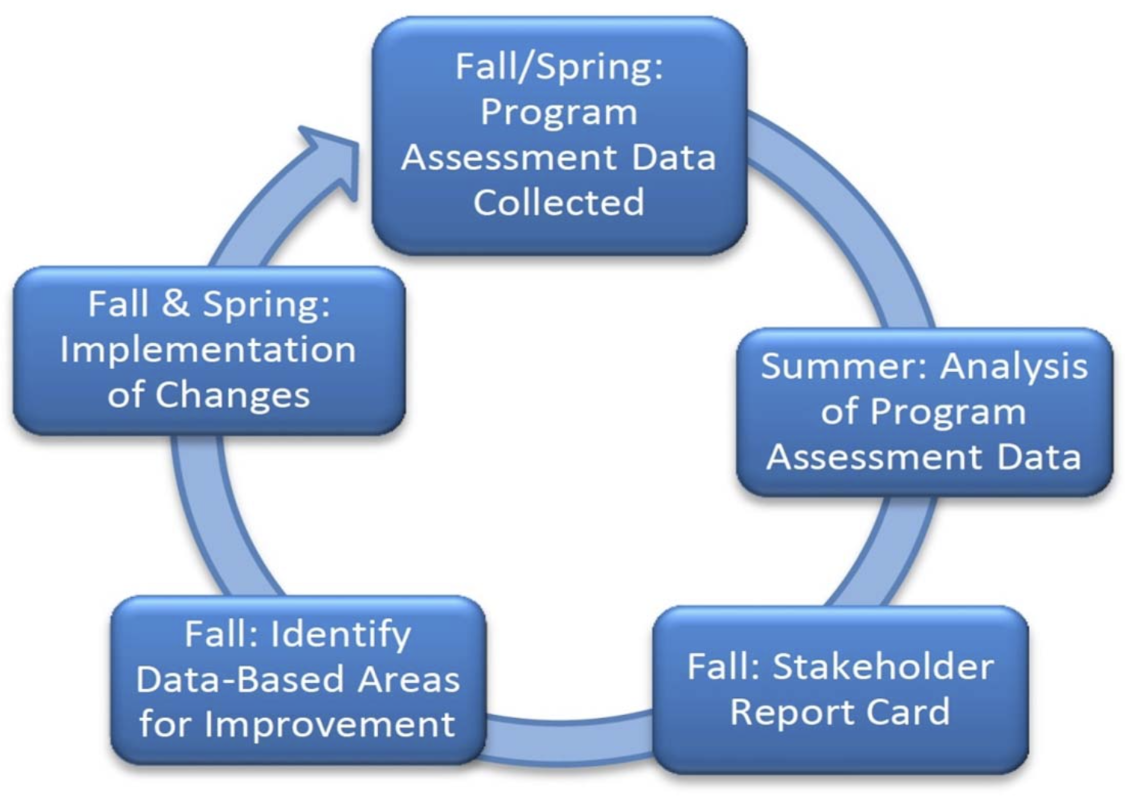
Program Learning Outcomes
Technology Education Industrial Technology Option
1 |
Concepts | Students understand are able to discuss and demonstrate broad technology concepts related to the areas of manufacturing, construction, power and energy, and communication. |
2 |
Ethics | Students recognize there are substantial interrelated ethical issues between technological advancements in industry and society, and as such are able to demonstrate their ability to engage in knowledgeable conscious decision making activities for future industrial practices through the research, analysis, and evaluation of historical events and industrial practices. |
3 |
Specifics | Students understand and can identify the advantages and disadvantages of various major materials and processes as they are employed in a multitude of current industry practices, as well as demonstrate the safe implementation and use of tools, equipment, and other resources specific to their industrial career focus. |
4 |
Application | Students engage in an internship program where they are able to apply their gained technological knowledge and skills in the industrial workforce while enhancing their understanding of and need for exemplifying professional ethics and good business practices in the field. |
Delivery - Technology Education Industrial Technology Option
| I = Introductory | Outcomes | ||||
| D = Developmental | Concepts | Ethics | Specifics | Application | |
| M = Mastery | Cr | 1 | 2 | 3 | 4 |
| M 151Q--Precalculus | 4 | I | |||
| COM 110US--Public Communication | 3 | ||||
| WRIT 101W--College Writing I | 3 | ||||
| TE 101--Intro to Technology Ed | 1 | I | I | ||
| EELE 101--Intro to Electrical Fundamentals | 2 | I | |||
| DDSN 114 --2-D Comp Aided Drafting | 3 | I | D | ||
| CHMY 121IN --Intro to Gen Chemistry | 4 | I | |||
| EGEN 105--Intro to Engineering | 2 | ||||
| EGEN 125--Tech, Innovation & Society | 3 | ||||
| M 165Q--Calculus for Technology I or STAT 216Q-- Intro to Statistics | 3 | I | |||
| TE 207--Materials & Processes | 4 | I | D | D | D |
| TE 250CS--Technology & Society | 3 | D | D | ||
| AGED 333--Construction Technology or ARCH 241-- Build Const | 3 | I | D | ||
| PHSX 205 --College Physics I | 4 | ||||
| TE 330--Alternative Power/Energy Technology | 3 | I | D | D | D |
| TE 331--Electronic & Video Communication | 4 | I | D | D | D |
| TE 410--Comp Aid & Industrial Mach & Manfc. | 4 | D | D | ||
| ENGR 301R --Multidisc Engineering Design | 3 | ||||
| TE 417--Manufacturing Technology | 3 | I | D | D | M |
| TE 498--Internship | 12 | D | D | M | |
Assessment - Technology Education Industrial Technology Option
| Outcomes | |||||
| Concepts | Ethics | Specifics | Application | ||
| Cr | 1 | 2 | 3 | 4 | |
| M 151Q--Precalculus | 4 | ||||
| COM 110US--Public Communication | 3 | ||||
| WRIT 101W--College Writing I | 3 | ||||
| TE 101--Intro to Technology Ed | 1 | ||||
| EELE 101--Intro to Electrical Fundamentals | 2 | ||||
| DDSN 114 --2-D Comp Aided Drafting | 3 | ||||
| CHMY 121IN --Intro to Gen Chemistry | 4 | ||||
| EGEN 105--Intro to Engineering | 2 | ||||
| EGEN 125--Tech, Innovation & Society | 3 | ||||
| M 165Q--Calculus for Technology I or STAT 216Q-- Intro to Statistics | 3 | ||||
| TE 207--Materials & Processes | 4 | ||||
| TE 250CS--Technology & Society | 3 | X | |||
| AGED 333--Construction Technology or ARCH 241-- Build Const | 3 | ||||
| PHSX 205 --College Physics I | 4 | ||||
| TE 330--Alternative Power/Energy Technology | 3 | ||||
| TE 331--Electronic & Video Communication | 4 | X | |||
| TE 410--Comp Aid & Industrial Mach & Manfc. | 4 | X | |||
| ENGR 301R --Multidisc Engineering Design | 3 | ||||
| TE 417--Manufacturing Technology | 3 | X | |||
| TE 498--Internship | 12 | X | |||
Programmatic Expectations
Technology Education Industrial Technology Option
Failure of our candidates to meet any of these expectations
would be interpreted as indicating an area in need of improvement.
| TE 331 ‐ Electronic Portfolio | We expect students to achieve a minimum overall score of 85% on the scoring rubric. |
| TE 250 ‐ Medical Technology Debates | Students participate in debates addressing specific issues related to medical technologies and society. Students are expected to achieve an 80% or higher in all criteria on the scoring rubric. |
| TE 410 ‐ Plum Bob | Students must read & understand a design layout in order to complete an accurate markup of material stock, and fabrication/machining of a plumb bob. Students are expected to score 80% or higher in all areas of the rubric prior to being approved to move on a final machining project. |
| TE 498 ‐ Internship | Students in the Internship are expected to achieve an overall score of 80% or higher from their Cooperator and On‐Campus Supervisor for the Final Evaluation. Demonstrated growth in eleven specific characteristics is expected to occur over the course of the Internship as indicated on the Final evaluation form. Students are expected to achiever a minimum of 75% on each of these individual characteristics. |
Assessment Schedule
Technology Education Industrial Technology Option
| Schedule for Assessing Each Outcome |
| We understand the university expects a three or four year cycle for each assessment, however it is important that our program content strives to meet current industry practices. Therefore faculty review assessment data each year in order to make modifications to the curriculum which reflect current industry practices. |
| Schedule for Reviewing Assessment Plan Elements |
|
Due to a change in Technology Education faculty during the last two years, review of program outcomes/assessments has not been conducted as it has been historically. This academic year a new tenure track faculty member has been hired and as such, a review of program assessments will once again take place annually. |
Annual Assessment Process
Technology Education Industrial Technology Option
| 1 | At the end of each semester Technology Education faculty come together to review the final grades assigned in each of the courses. |
| 2 | Courses in which students did not attain the minimum scores are identified. |
| 3 | A review of the student(s) progress in the course takes place and areas of weakness are noted. |
| 4 | If in fact multiple students did not meet the minimum expectations of a course and demonstrated similar areas of weakness in a course, those areas are flagged as needing modification/improvement prior to the next offering of the course. |
| 5 | When course design takes place for the next offering of the course(s) curricular changes are implemented in areas such as, but not limited to, course reading materials, demonstrations, activities, projects, mid‐ term & final course assessments. These changes are based on a review of current practice both in the classroom and industry, as well as previous course evaluations. |
| 6 | Upon completion of the revised course, faculty first evaluate student performance in the previously identified areas of weakness to ensure the modifications to the course resulted in an increase in student(s) achievement. |
Field Experience Performance Assessment (FEPA)
Scoring Rubric
| Not Scored Value = NS [Recorded as 0, but excluded from calculations] |
Below Expectations |
Meets Expectations Value = 2 Performance observed at expected level |
Exceeds Expectations Value = 3 Performance exceeds criteria defined by indicators of expected behaviors |
| Content | C1 | Demonstrates understanding of the central concepts and structures of the discipline |
| C2 | Creates experiences that allow students' to develop their own understanding | |
| C3 | Implements learning experiences aligned with content standards | |
| C4 | Creates learning experiences that are purposeful, appropriate and relevant to learners | |
| Diversity | D1 | Fosters a learning environment that supports/encourages social and academic success for all students |
| D2 | The instruction demonstrates an awareness of students' developmental needs | |
| D3 | Incorporates Indian Education for All into instruction | |
| D4 | Connects content to students' personal, family and/or community experiences | |
| D5 | Adapts instruction to accommodate for diversity in a culturally responsive manner | |
| Pedagogy | P1 | Differentiates instructional strategies to encourage the development of conceptual understanding |
| P2 | Incorporates student motivation for learning | |
| P3 | Incorporates higher order thinking or problem solving skills when teaching | |
| P4 | Incorporates teaching strategies to strengthen students' 21 st century skills | |
| P5 | Employs effective communication techniques to enhance the development of student understanding | |
| P6 | Integrates media and learning technologies to support instruction and student learning | |
| P7 | Uses a variety of classroom management techniques to promote a positive learning environment | |
| Assessment | A1 | Uses a variety of assessment strategies that are appropriate for the learning outcomes being evaluated |
| A2 | Uses assessment strategies to monitor student progress to modify teaching and learning strategies | |
| A3 | Provides students with descriptive feedback | |
| A4 | Assessment strategies are aligned with students' developmental needs | |
| Professionalism | R1 | Reflects on content to improve teaching and student learning |
| R2 | Reflects on diversity to improve teaching and student learning | |
| R3 | Reflects on pedagogy to improve teaching and student learning | |
| R4 | Reflects on assessments to improve teaching and student learning | |
| R5 | Reflects and identifies areas for future professional growth | |
| R6 | Reflects on personal biases | |
| R7 | Reflects on the lesson's connection to students' personal, social and cultural experiences |
Teacher Work Sample (TWS)
Scoring Rubric
|
N/A Indicators not Observed [Counts as 0, since everything is required.] |
1 = Below Expectations Fails to meet expected level of performance in content, presentation, and/or professional writing. |
2 = Meet Expectations Demonstrates appropriate level of performance in content, presentation, and/or professional writing. |
3 = Exceeds Expectations Surpasses expected level of performance in content, presentation, and/or professional writing. |
| SECTION ONE: Contextual Factors |
The candidate provides evidence of understanding community, school, classroom, and student contextual factors. The candidate has selected factors affecting student learning and instruction, including evidence of how to use those factors in instructional decision‐making. The candidate presents specific data to analyze and reflect on the work done in Section One. | Community Context |
| School Context | ||
| Classroom Context | ||
| Student Characteristics | ||
| Conclusion | ||
| SECTION TWO: Aligned Unit and Lesson Planning |
The candidate selects appropriate content standards and supports them with carefully planned unit goals and assessments. Lesson planning aligns with content standards and lesson sequence planning. The lesson sequence, lesson objectives, and lesson assessments support content standards, the unit goals and assessments. The candidate presents specific data to analyze and reflect on the work done in Section Two. | Unit Planning and Assessment |
| Lesson Planning Alignment | ||
| Conclusion | ||
| SECTION THREE: Instructional Planning and Student Achievement |
The candidate writes lesson plans which connect to all concepts and align with TWS Sections One and Two to support the learning of all students. Lesson plans need to include all required elements and are attached in Appendix A of the TWS. The candidate collects and presents the pre‐, formative, and summative learning achievement data for the whole class and one subgroup or one case study and presents specific data to analyze and reflect on the work completed in in this section. | Lesson Plans |
| Whole‐class Data Analysis | ||
| Individual or Subgroup Data Analysis | ||
| Conclusion | ||
| SECTION FOUR: Self‐Assessment and Reflection |
The candidate uses specific data and reflective skills to a) analyze the effectiveness (strengths and weaknesses) of the learning sequence of the TWS; b) analyze the effectiveness (strengths and weaknesses) of his or her personal performance in all areas of instruction, c) develop personal and specific professional goals as well as action plans to achieve these goals. | Unit Product Assessment and Reflection |
| Personal Performance Assessment and Reflection | ||
| Personal Goals and Action Plans |
Current courses: EDU 397/497 (Various sections indicate various methods courses.)
| The 0 to 3 scale on this assignment is used as a guide in converting the other signature assignments to the same scale |

Current courses: EDU 222IS/223IS
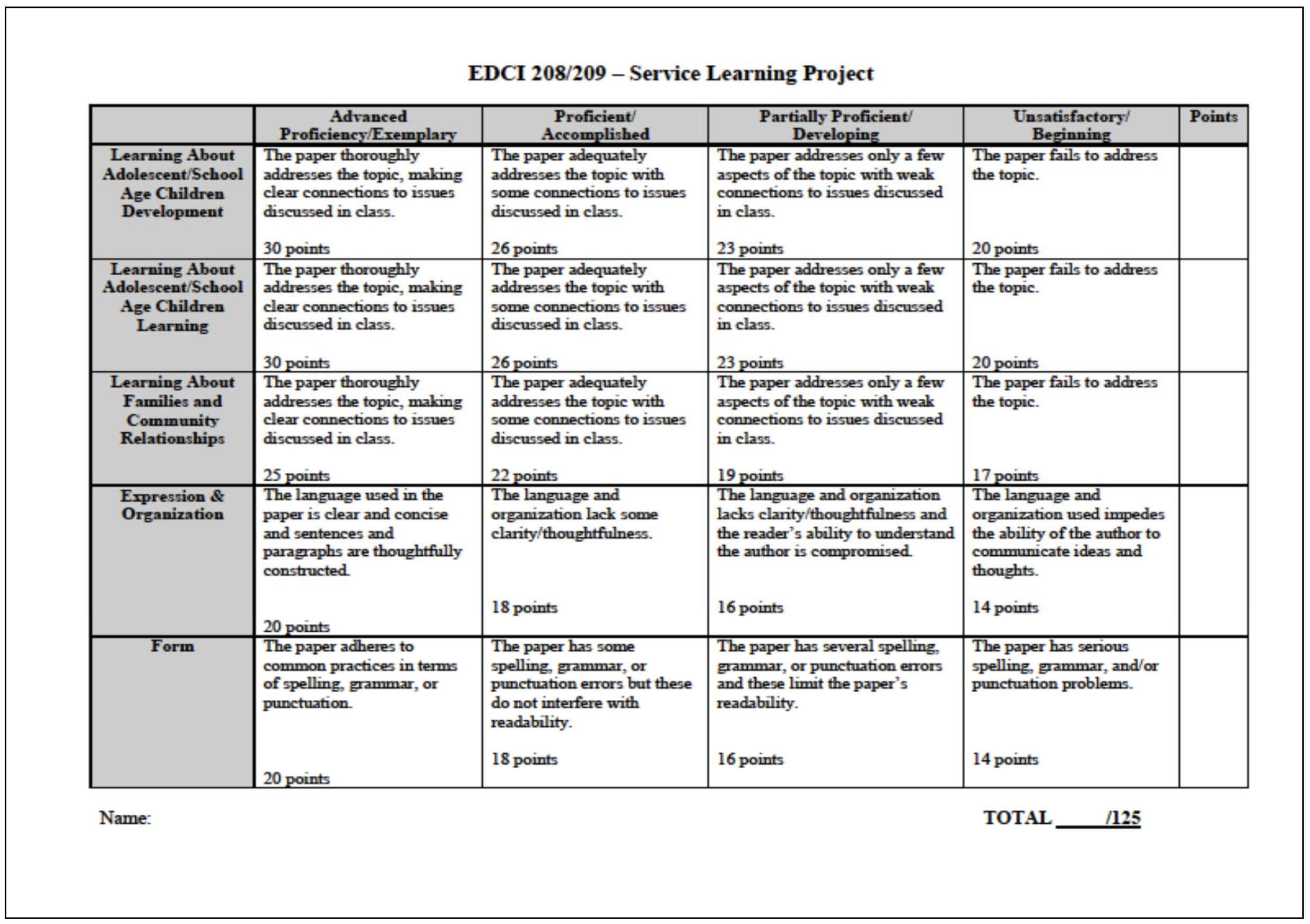
Current course: EDU 395
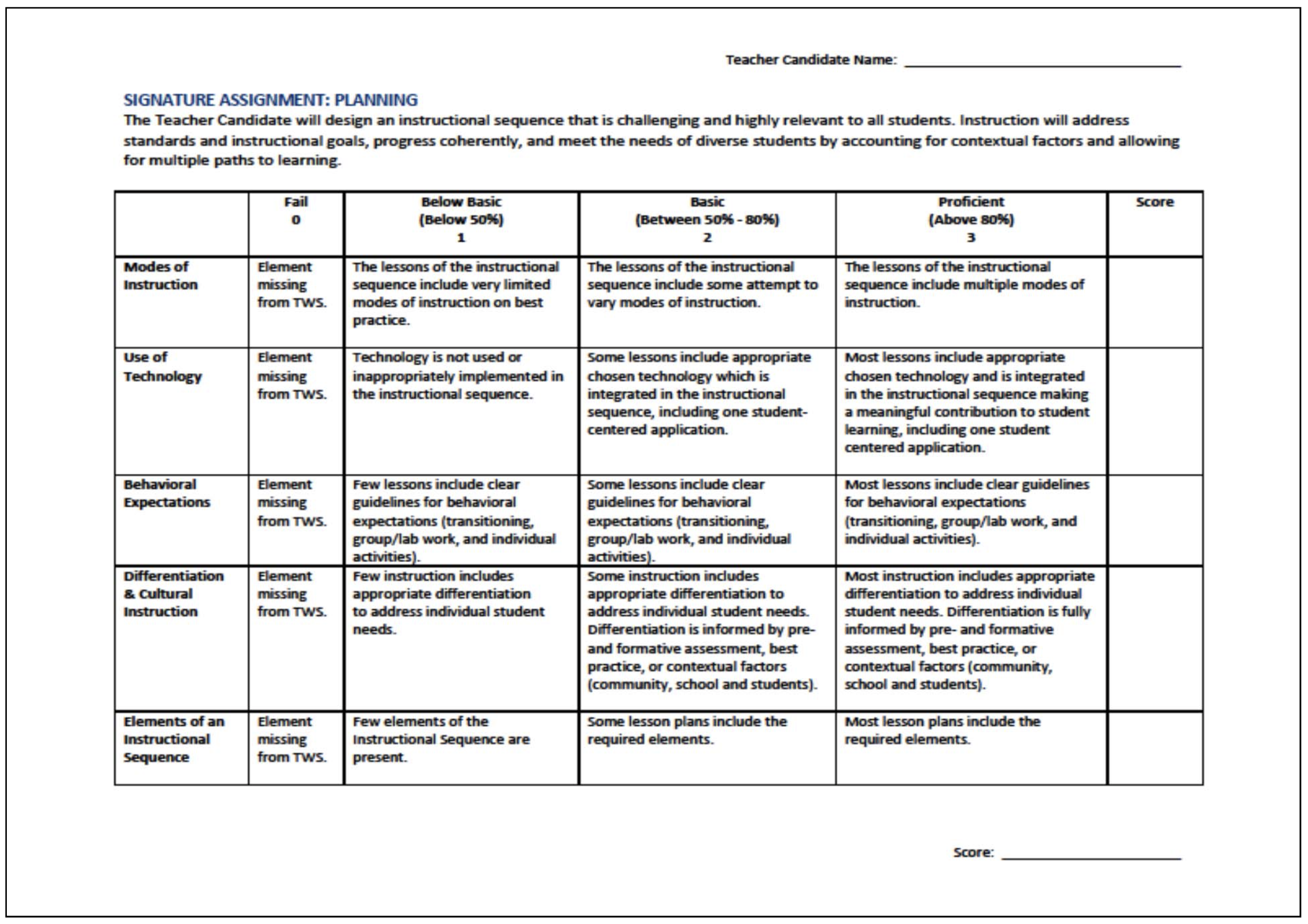
Current course: EDU 395
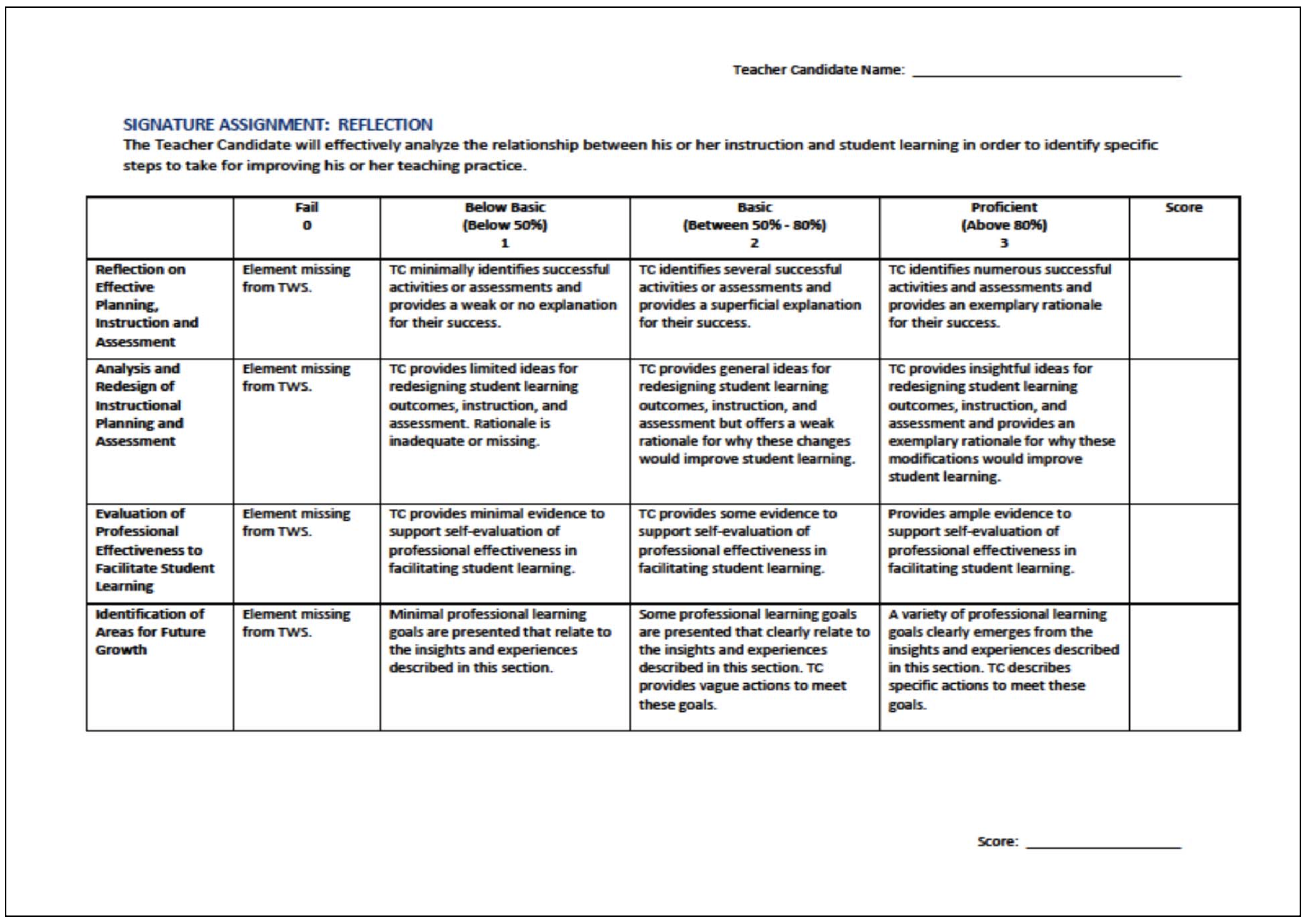
Current course: EDU 211D
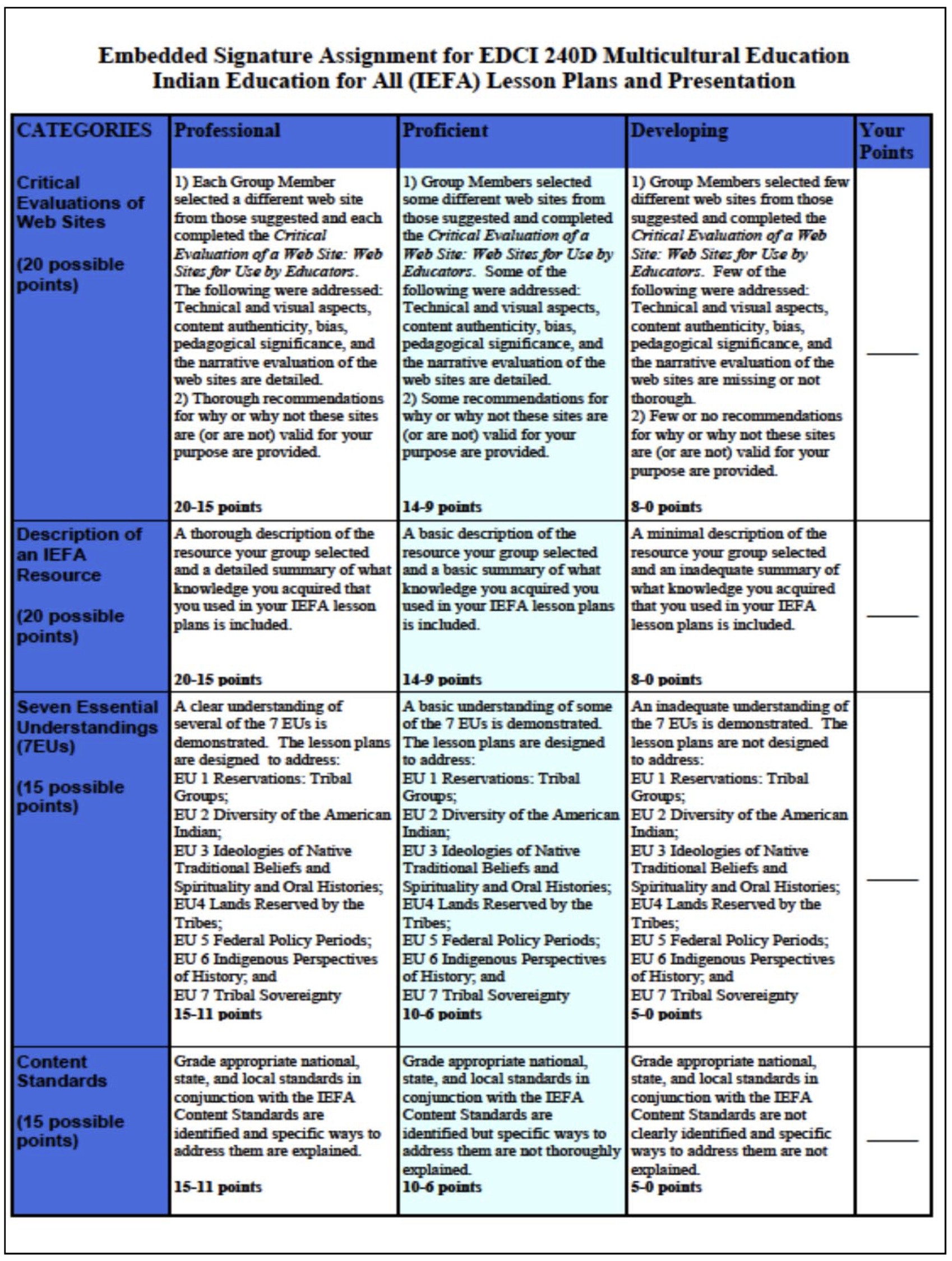
Current course: EDU 370
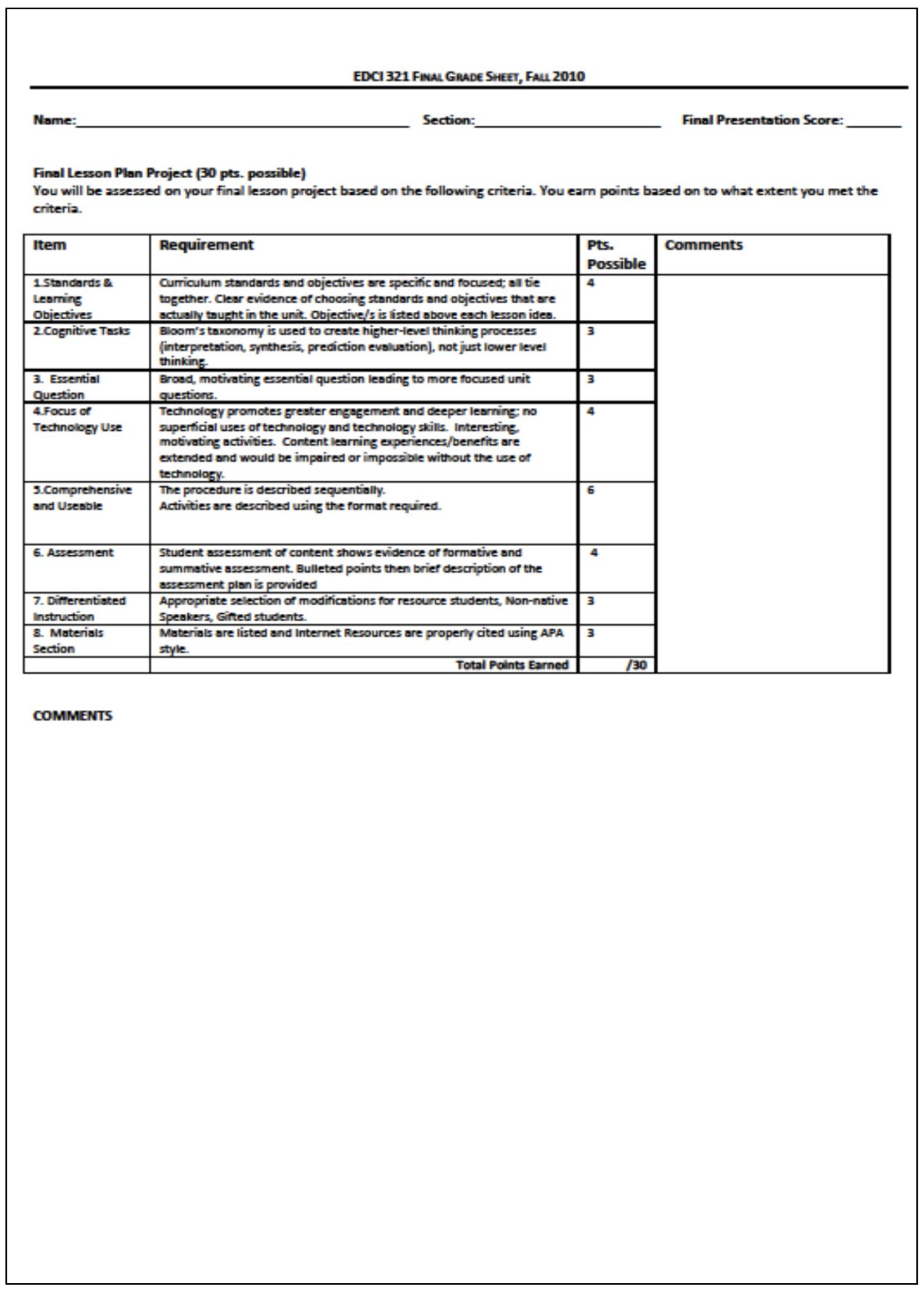
Current course: EDU 382
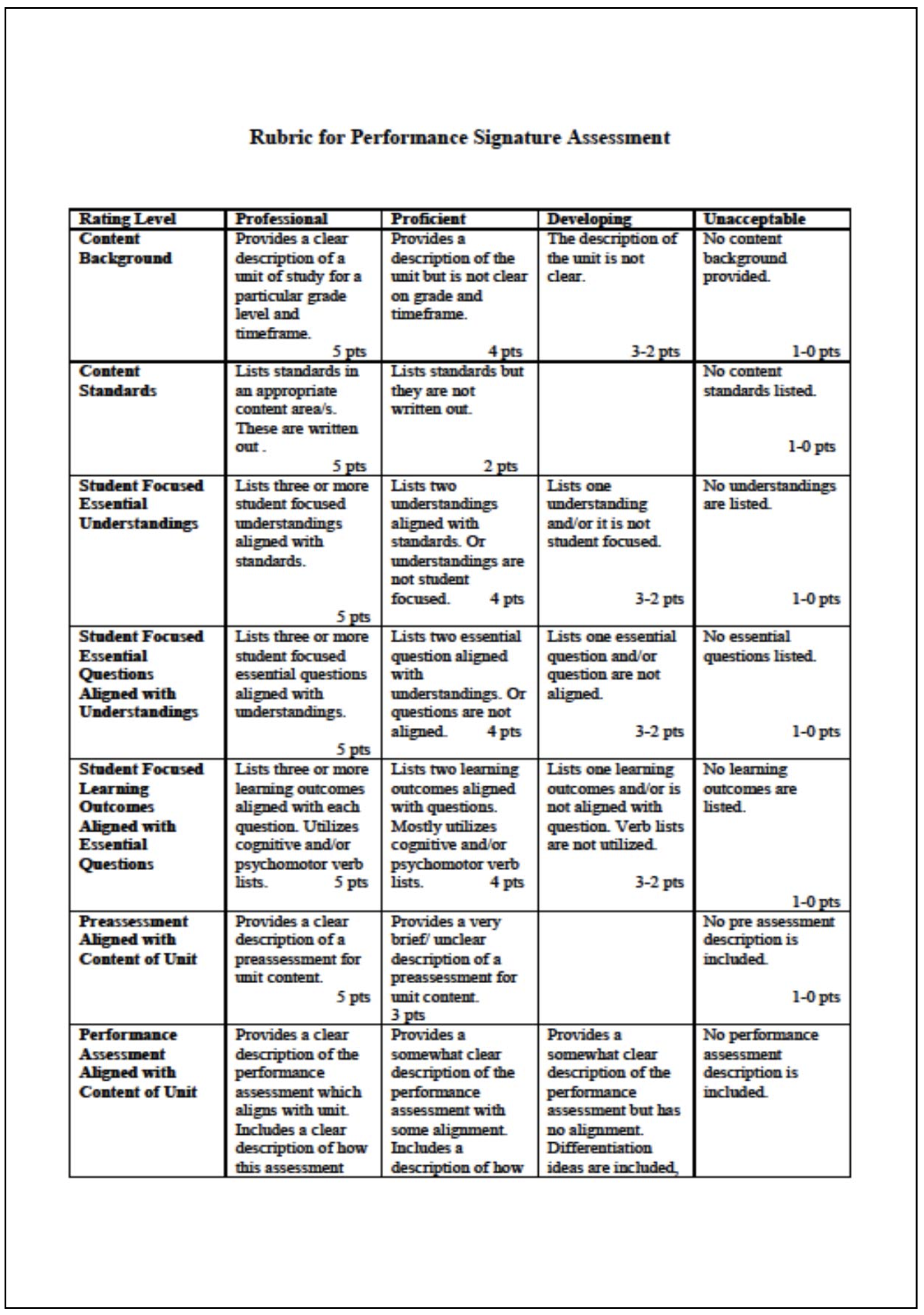
Current course: EDU 382

TE 331 - Portfolio Rubric
Instructor Name: ____________________________________________
Student Name: ____________________________________________
|
Category |
5 | 4 | 3 | 1 | SCORE X 2 |
| Portfolio Navigation | All links work in the portfolio. | 90% of the links work in the portfolio. | 80-89% of the links work in the portfolio. | 70-79% of the links work in the portfolio. | |
| Organization | Content is well organized using headings or bulleted lists to group related material. | Uses headings or bulleted lists to organize, but the overall organization of topics appears flawed. | Content is logically organized for the most part. | There was no clear or logical organizational structure, just lots of facts. | |
| Attractiveness | Makes excellent use of font, color, graphics, effects, etc. to enhance the presentation. | Makes good use of font, color, graphics, effects, etc. to enhance presentation. | Makes use of font, color, graphics, effects, etc. but occasionally these detract from the presentation content. | Use of font, color, graphics, effects etc. but these often distract from the presentation content. | |
| Grammar and spelling | There are no misspelled words on the web page or pages. Correct grammar is used throughout website. | There are few misspelled words on the web page or pages. Correct grammar is used throughout website. | There are less than 10 misspelled words on the web page or pages. Correct grammar is used throughout website. | There are several misspelled words on the web page or pages. Correct grammar is used throughout website. | |
| Content | Contains: resume, course descriptions of major, writing samples, digital movies, and other representative artifacts. | Contains 90% of artifacts required. | Contains 80% of artifacts required. | Contains 70% of artifacts required. | |
| Design Considerations | Web page design does not detract from content. Pages are short with little or no scrolling required to view page. Page format is consistent. | Few web page design elements detract from content. | Half of page design detracts from content. | Most of page design detracts from content. | |
| COMMENTS: | 0 TOTAL |
TE 250 - Medical Technology Debate Rubric
| Category | 5 | 4 | 3 | 1 |
| Topic Introduction | Introduction is well organized, identifies the specific medical technology, and the factors influencing the position of the group/student. | Introduction is organized, identifies the medical technology and current position of the group/student. | Introduction identifies the medical technology and offers some insight into the possible position of the group/student. | Introduction is fragmented and does not really introduce the topic or the group/student position. |
| Initial Response to Moderator Questions | Group/Student responses to questions are direct; prepared; address all aspects of the question using supporting research and specific citations from that research. Answers support the position of the group/student and infer weakness in the opposing sides position as answer heavily influence the audiences position on the topic. | Group/Student responses to questions address all aspects of the question using supporting research and specific citations from that research. Answers support the position of the group/student and infer weakness in the opposing sides position. | Group/Student responses to questions address some aspects of the question using source citations. Answers offer little support for the position of the group/student. | Group/Student responses to questions address some aspects of the question using no source citations. Answers appear to be somewhat off topic and based on opinion not research. |
| Rebuttal to Opponents Question Response | Group/Student rebuttals address specific issues presented by the opposing side; includes multiple citations and specific examples; supports the pro or con side of the argument. Information is based on research and fact, no opinions. Group/student rebuttals includes identified ethical issues which influence pro/con stance. | Group/Student rebuttals address specific issues presented by the opposing side; includes citations and specific examples; supports the pro or con side of the argument. Information is based on research and fact, no opinions. Group/student rebuttals identify possible ethical issues. | Group/Student rebuttals address issues presented by the opposing side with broad responses; may include citations or examples. Information is based on some research and some voiced opinions. Group/student rebuttals do not identify possible ethical issues. | Group/Student rebuttals do not address specific issues presented by the opposing side; do not include citations or examples. Little information is based on research; mostly opinions are expressed. Group/student rebuttals do not identify possible ethical issues |
page 1 of 2
| Category | 5 | 4 | 3 | 1 |
| Societal / Ethical issues | Group/Student cite numerous (more than 3) specific examples, both positive and negative, of societal / ethical issues related to the medical technology and offer suggestions to address these. Group/student presents specific numerous historical examples to inform audience and strengthen argument. | Group/Student cite specific examples (1 or 2), both positive and negative, of societal / ethical issues related to the medical technology and offer some suggestions to address these. Group/student presents an historical example to inform audience and influence argument. | Group/Student cite broad example, either positive or negative, of societal / ethical issues related to the medical technology but offer few/no suggestions to address these. Group/student presents historical example which neither informs audience and or influences argument. | Group/Student cite no examples of societal / ethical issues related to the medical technology. Group/student presents no historical example. |
| Time Limits | Group/Student stayed within all specified structured time limits for the debate and the over time limit. | Group/Student stayed within most specified structured time limits for the debate phases and within the overall established time limit. | Group/Student went over or under all specified time limits for the debate phases but stayed within the overall established time limit. | Group/Student went over or under all specified time limits for the debate phases including the overall established debate time limit. |
| Source Citation | Group/Student cited a minimum of three sources during each phase of the debate; all citations are from peer reviewed articles/journals and verified medical resources. | Group/Student cited the minimum of three sources for most phases of the debate; most citations are from peer reviewed articles/journals. | Group/Student cited three sources during the whole debate; few citations are from peer reviewed articles/journals. | Group/Student cited fewer than three sources for the entire debate; none from peer reviewed articles/journals |
| Group Presentation | Group/Student keeps presentation and arguments focused on the actual chosen medical technology throughout the presentation. All members of the group are actively engaged in the debate research & process. | Group/Student keeps the presentation and arguments focused on the actual chosen medical technology the majority of time. Most members of the group are actively engaged in the debate research & process. | Group/Student occasionally wander from the actual chosen medical technology but are able to get back on task. It is apparent that only a few members of the group were actively engaged in the debate research & process. | Group/Student appear to struggle keeping presentation and arguments focused on the actual chosen medical technology. Group seems fragmented and unprepared with their research and presentation of information. |
| COMMENTS: | ||||
| TOTAL |
page 2 of 2
TE 410 ‐ Plumb Bob Project
| CATEGORY | 5 | 3 | 1 | X 2 |
| Material Choice | Student presented documented evidence of researching various materials type. | Student presented some evidence of researching materials types. | Student presented little to no evidence of researching various materials types. | |
| Material Use | Student was able to describe the physical, mechanical, and chemical properties of the researched materials as they related to manufacturing and specified use of a plumb bob. | Student addressed some of the physical, mechanical, and chemical properties of the researched materials as they related to manufacturing and specified use of a plumb bob. | Student noted only one or two physical, mechanical, and chemical properties of materials and made minimal connection to the manufacturing and specified use of a plumb bob. | |
| Dimensions: Taper |
Object meets exact dimensions set in engineering drawing. | Object is within allowable tolerances: +/‐ .003". | Object is outside tolerances. | |
| Dimensions: Holes |
Object meets exact dimensions set in engineering drawing. | Object is within allowable tolerances: +/‐ .003". | Object is outside tolerances. | |
| Dimensions: Shoulder & Shank Length |
Object meets exact dimensions set in engineering drawing. |
Object is within allowable tolerances: +/‐ .003". | Object is outside tolerances. | |
| Finish | Object was polished and sealed. Very few major scratches can be detected. | Object was only partly polished and sealed. There were several scratches marring the finish. | Object was not sealed and there were several scratches marring the finish. | |
| Safety | Student modeled all established rules of safety in the lab area and in using tools/equipment. | Student employed some of the established rules of safety in the lab area but needed to be reminded of several specific rules regarding tools use. | Student employed minimal established rules of safety in the lab area and in using tools/equipment, and required constant supervision. | |
| Time on task | Student used allotted lab time to complete project by deadline. | Student did not use allotted lab time to complete project in a timely manner. | Student was late in completing project. | |
| Total Points: |
TE 498 - Internship Rubric
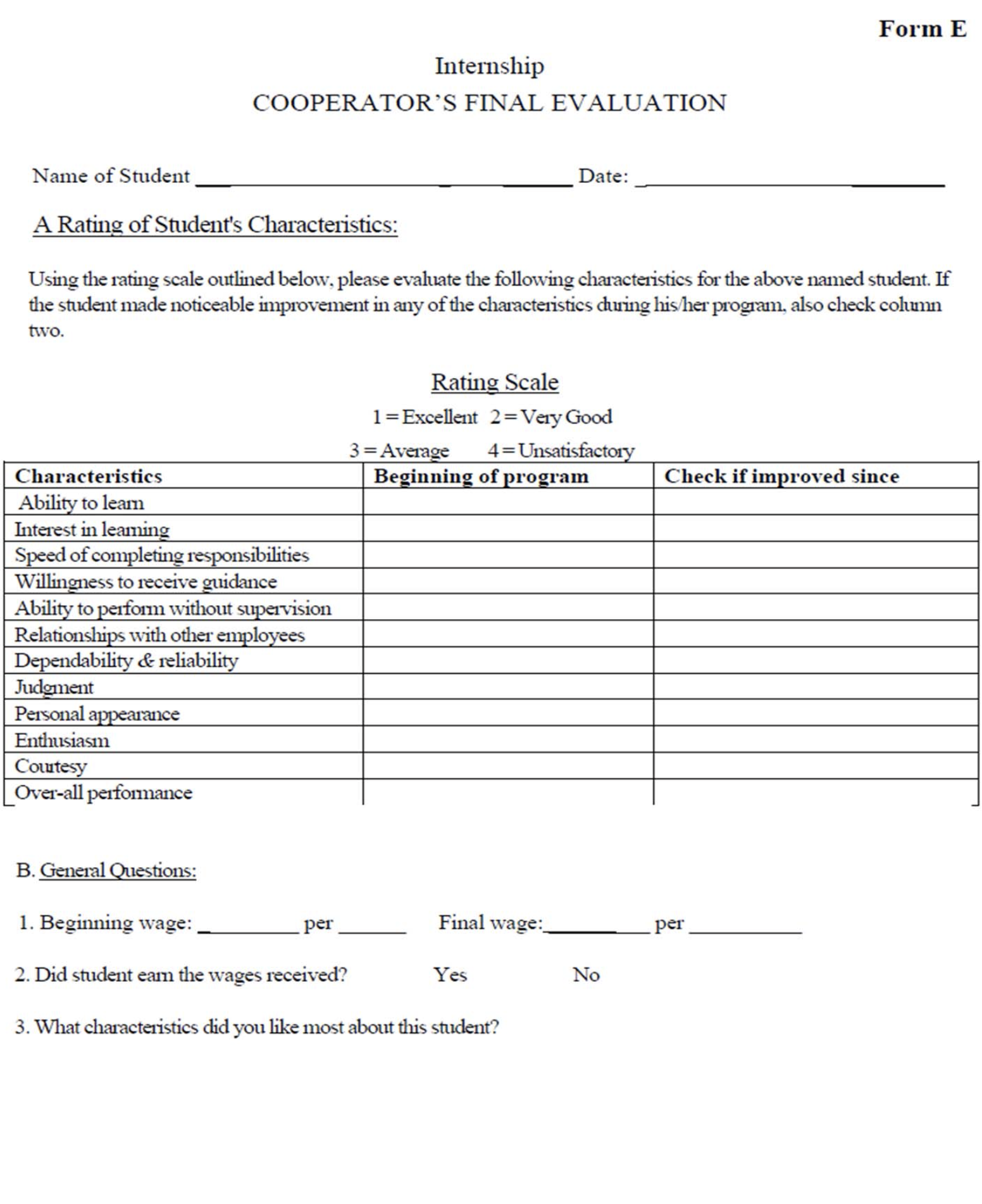
Page 1 of 5
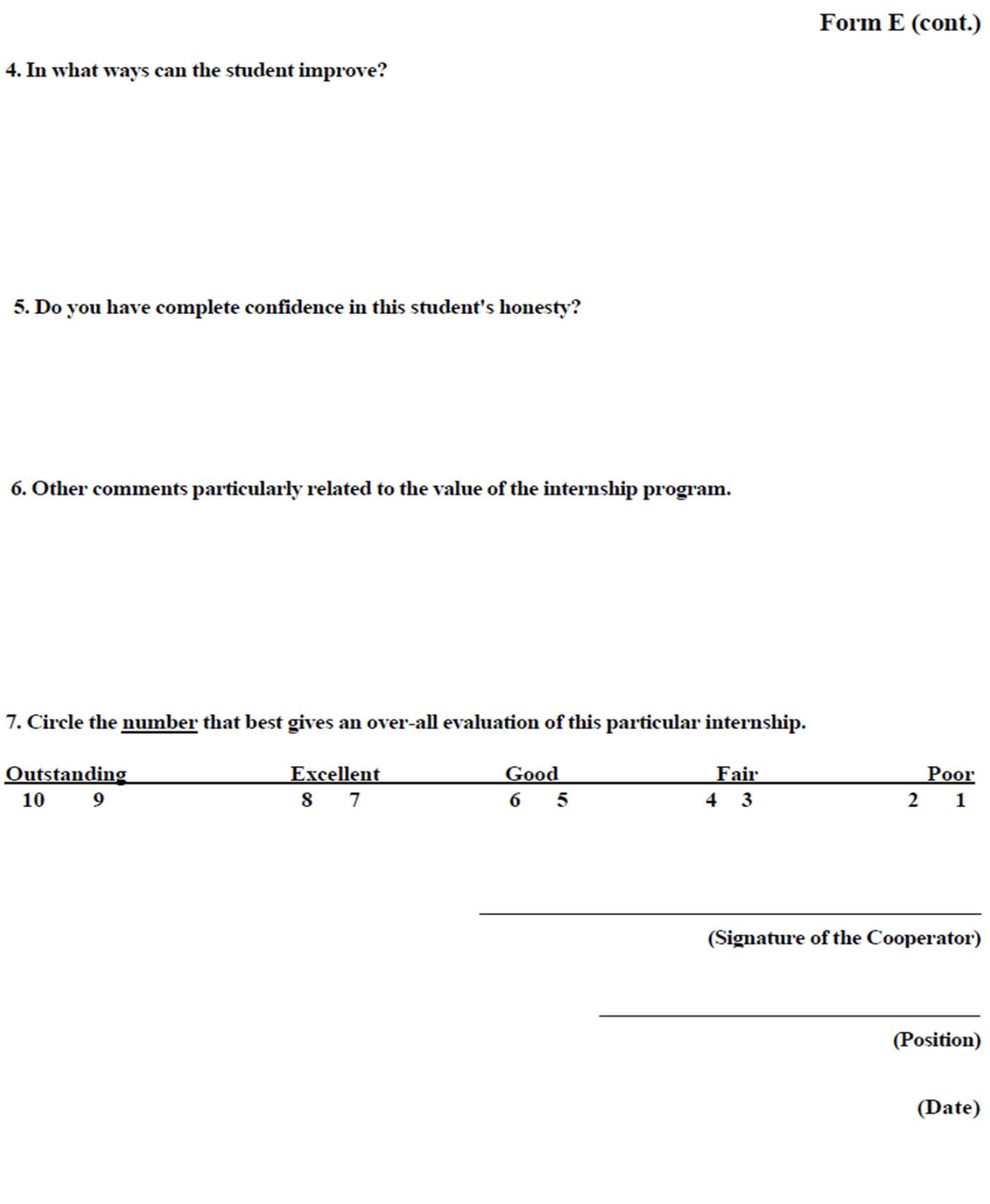
Page 2 of 5
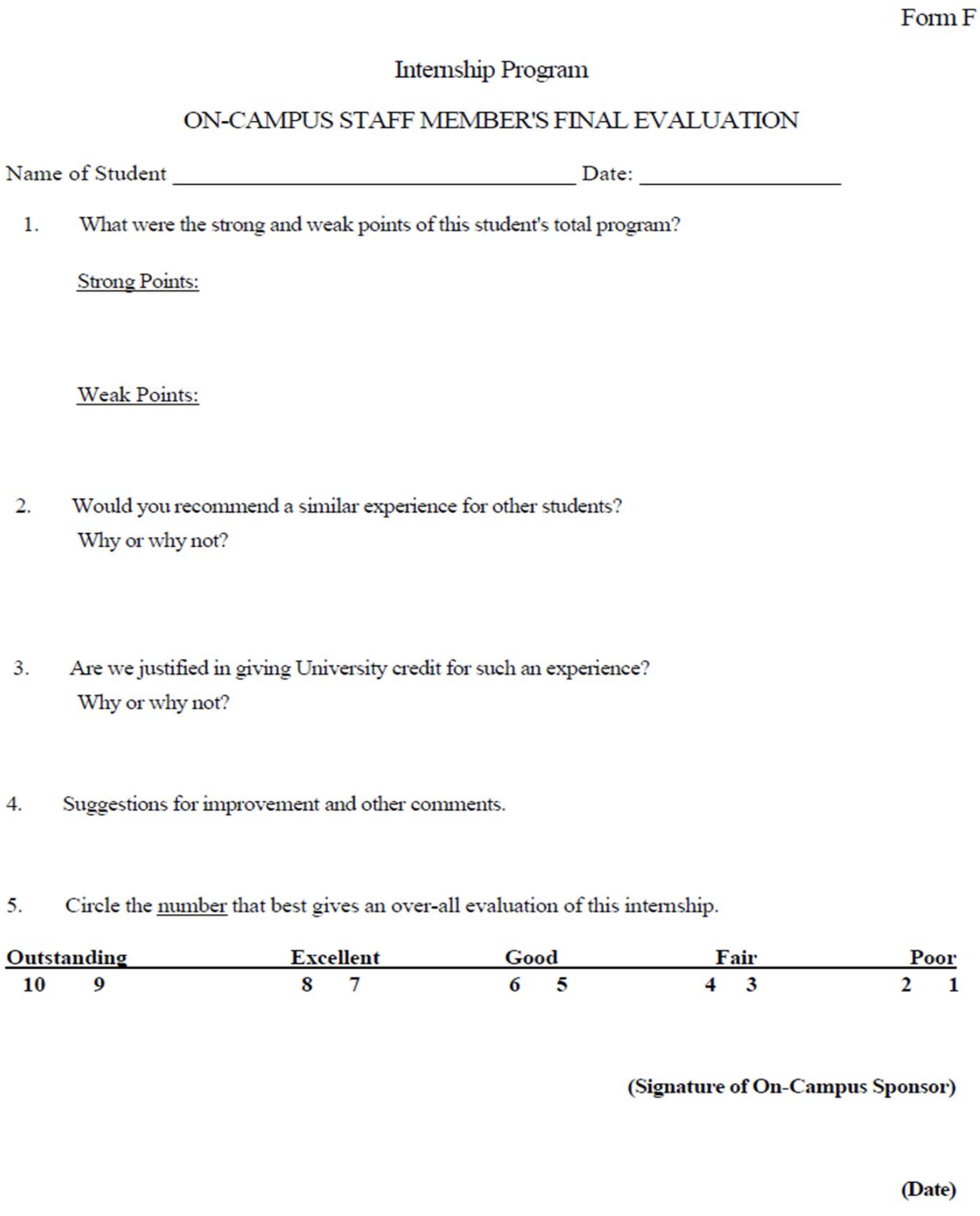
Page 3 of 5
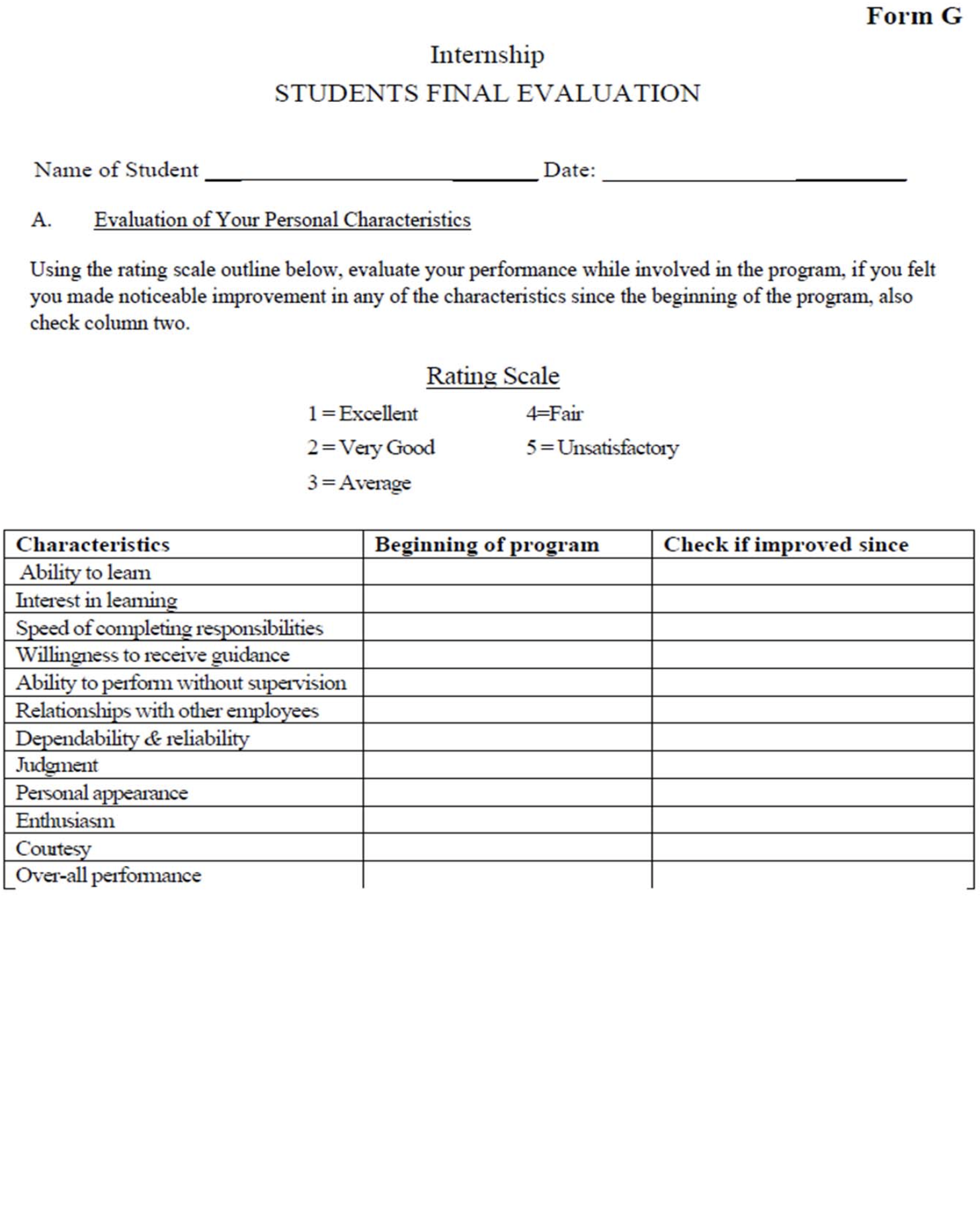
Page 4 of 5
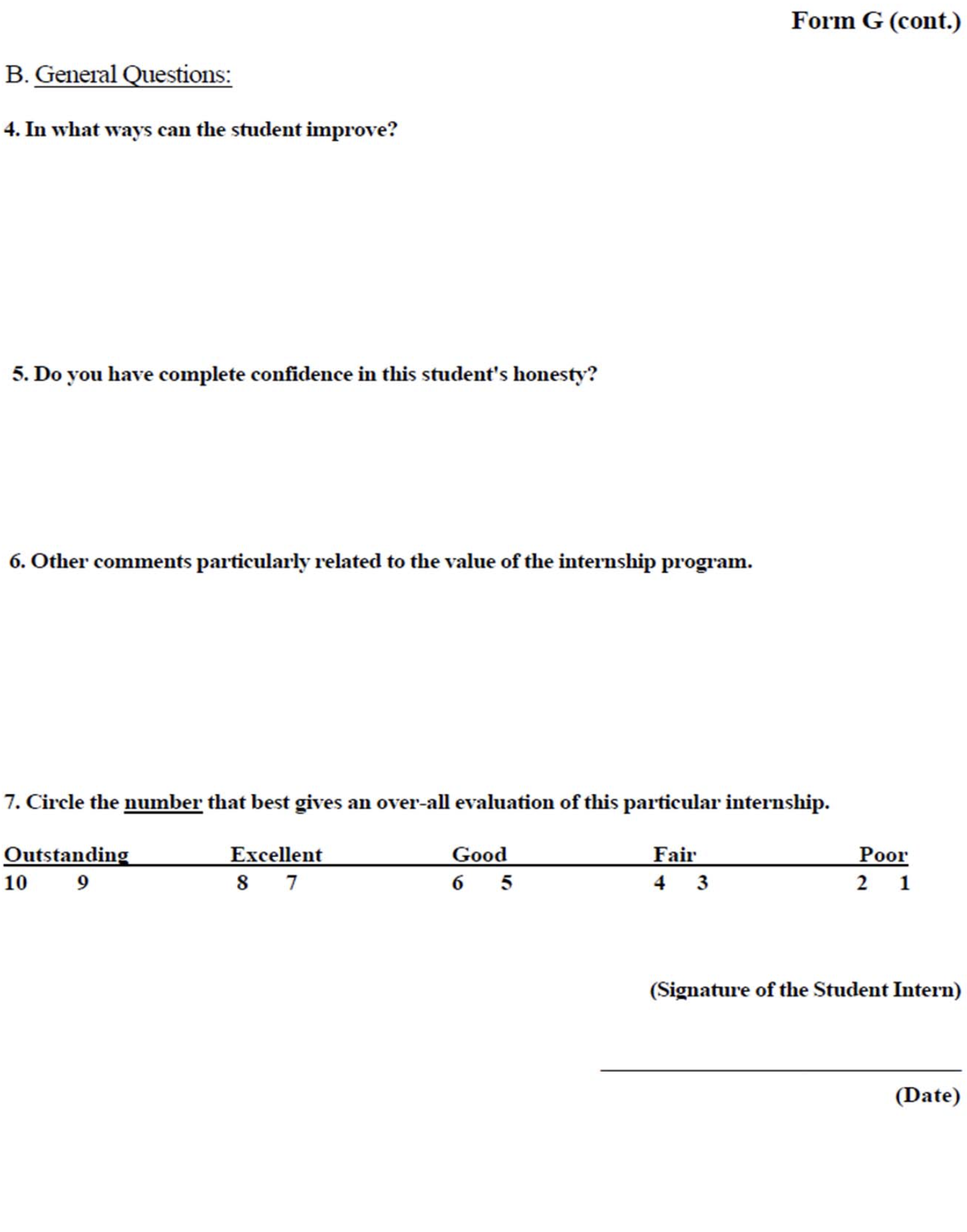
Page 5 of 5



